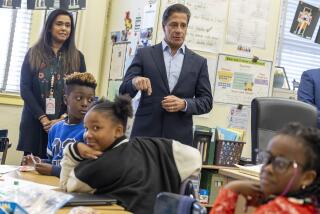EDUCATION A SENSIBLE SOLUTION : Year-Round Schools Plan Makes Space for Teaching : New calendar will enhance the quality of learning. The few drawbacks are easily remedied.
- Share via
The school year as we know it--from September to June--is a remnant of rural America, a time when children were needed in the summer months to help work in the fields. The Los Angeles of farms, ranches and orange groves is long gone, of course. In its place stands a sprawling metropolis with the second-largest school district in the country and an alarming shortage of classrooms and teachers.
In deciding to put its schools on a year-round calendar, the Los Angeles school board selected the most cost-efficient, expedient and sensible way to relieve grossly overcrowded schools. Stop-gap measures--such as busing inner-city and Eastside students great distances to less crowded schools--provided an inconvenient, impractical and, above all, inequitable solution.
The Los Angeles Unified School District has neither the land nor the money--nor, for that matter, the time--to build enough new classrooms to accommodate the district’s projected growth of 15,000 students a year. Busing takes an unfair toll on the children who must spend hours shuttling between home and less crowded schools in unfamiliar neighborhoods. This routine would undoubtedly take its toll in the classroom, as well as during what should be peak homework hours. Children do not have limitless energy and cannot be compared to adults who commute by their own choice.
The board’s proposal to put all district schools on a multi-track calendar by the year 1991 will generate 60,000 extra seats without the expense and time constraints of additional construction. By moving to such a system, the district will be able to increase its capacity by a one-third without lengthening the school year.
What’s more, contrary to the claims of some critics, a year-round calendar will enhance the quality of education in public schools by diminishing the learning loss that tends to occur during extended summer vacations. The 30-day vacations will provide students with a more cohesive and continuous learning environment, in addition to greater opportunities for more frequent remediation when necessary. Intense concentration on subjects, with the proper guidance and lesson planning, will enable students to retain information as well, if not better, than during the traditional school year. Students in colleges and universities on a quarter system arguably learn as much as their counterparts in institutions on a more traditional and longer semester system.
As with any solution, there are drawbacks to year-round schooling, but they are few and easily remedied. Critics who complain that students will be forced to attend school during the hot Los Angeles summer forget that temperatures often peak well within the already-established school year--in September and October. And installing air conditioning is cheaper and faster than building additional facilities to house the relentless student influx.
Some of the most vocal critics of the proposal claim that the new school year will eliminate the possibility for family vacations, or at least make coordination of family-member schedules more difficult. To base education policy on vacation convenience is absurd. The proposal does not lengthen the school year, nor does it eliminate vacation times; it simply rearranges them. Thirty days of vacation will follow each 90-day school term. As for anxieties that the plan will disrupt family unity, district officials have vowed to make every effort to place children in any given family on the same track.
The proposal--in itself a flexible and creative way of addressing a serious problem--provides students, parents and teachers with a wide range of hitherto unexplored options. Companies that have been creating summer jobs for students could create regular, year-round positions that would continually be filled by students from alternating tracks, bringing a greater sense of responsibility and continuity to the workplace. And teachers could elect to switch tracks when their particular track went on vacation, thus teaching full time, earning more and alleviating the teacher shortage.
A decision to change what has been the accepted norm for decades takes courage to return to the primary mission of any school district: teaching children rather than scavenging for space.
Los Angeles has become a melting pot of immigrants. They come here in search of better conditions, a better climate, a better life. Many are underprivileged; many do not speak English; many cannot afford to educate themselves. The public school system holds out a promise of an education and a better life for their children. In a district as overcrowded as ours, where every day is a constant struggle for more space, only year-round schooling can keep that promise and allow our public schools to provide quality education for all.
More to Read
Sign up for Essential California
The most important California stories and recommendations in your inbox every morning.
You may occasionally receive promotional content from the Los Angeles Times.













